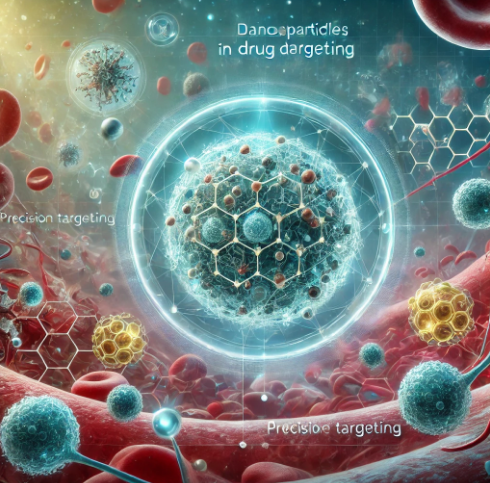Introduction:
Nanomedicine, the application of nanotechnology in medicine, has been a groundbreaking advancement in the pharmaceutical industry. It involves the use of nanoparticles to deliver drugs more effectively, precisely targeting diseased cells while minimizing damage to healthy tissues. This technology has the potential to revolutionize treatments for various diseases, including cancer, cardiovascular diseases, and neurodegenerative disorders. In this article, we explore the science behind nanomedicine, its applications in drug delivery, challenges, and the future of this promising field.
The Science Behind Nanomedicine
Nanoparticles, typically ranging from 1 to 100 nanometers in size, possess unique physical, chemical, and biological properties. These characteristics enable nanoparticles to interact with biological systems in novel ways, improving drug solubility, stability, and bioavailability.
- Types of Nanoparticles Used in Drug Delivery
- Liposomes: These are spherical vesicles made of lipid bilayers, commonly used to encapsulate drugs. They enhance drug stability and prolong circulation time in the bloodstream.
- Polymeric Nanoparticles: These consist of biodegradable polymers, which allow for controlled drug release over extended periods.
- Gold Nanoparticles: Known for their ability to absorb light and convert it to heat, gold nanoparticles are used in photothermal therapy to destroy cancer cells.
- Dendrimers: Highly branched synthetic molecules that can carry multiple drug molecules, enhancing their delivery efficiency.
- Mechanism of Action
- Nanoparticles can be engineered to target specific tissues or cells, such as cancer cells, by attaching ligands to their surface that recognize and bind to receptors on the target cells. Once bound, the nanoparticles release the drug payload directly into the diseased cells, reducing side effects and increasing therapeutic efficacy.
Applications of Nanomedicine in Drug Delivery
The ability to precisely deliver drugs to specific sites in the body makes nanomedicine a powerful tool for treating a wide range of diseases. Some of the key applications include:
- Cancer Treatment
- One of the most promising areas of nanomedicine is in oncology. Nanoparticles can carry chemotherapeutic agents directly to tumor cells, reducing the toxic effects of chemotherapy on healthy tissues. Additionally, nanoparticles can be used for both diagnosis and therapy, a field known as theranostics.
- Targeted Drug Delivery for Cardiovascular Diseases
- Nanoparticles can be used to deliver drugs directly to damaged heart tissues or to prevent the formation of arterial plaques, offering new treatments for heart disease and stroke prevention.
- Neurodegenerative Disorders
- Diseases like Alzheimer’s and Parkinson’s present challenges in drug delivery due to the blood-brain barrier (BBB). Nanoparticles have the ability to cross the BBB, offering a potential solution for delivering drugs to the brain.
- Antibiotic Resistance
- Nanomedicine is being explored as a solution to antibiotic resistance. Nanoparticles can be used to deliver antibiotics more effectively to infected areas, bypassing resistant bacteria’s defense mechanisms.
Challenges in Nanomedicine
Despite its promise, nanomedicine faces several challenges that must be addressed for its widespread adoption:
- Toxicity and Biocompatibility
- While nanoparticles can improve drug delivery, their long-term effects on the body are still not fully understood. Some nanoparticles may accumulate in organs and tissues, causing potential toxicity. Ensuring biocompatibility is crucial for safe use in humans.
- Manufacturing and Scalability
- Producing nanoparticles consistently and at a large scale remains a challenge. The complexity of manufacturing processes can make nanomedicine treatments expensive and difficult to produce in large quantities.
- Regulatory Hurdles
- The regulatory framework for nanomedicine is still evolving. Due to the unique properties of nanoparticles, traditional drug approval processes may not be sufficient. New guidelines and safety standards are needed to assess the risks and benefits of nanomedicine products.
- Public Perception
- There are concerns about the safety of nanotechnology, particularly regarding its potential environmental and health impacts. Public education and transparent communication will be essential for building trust in nanomedicine.
The Future of Nanomedicine
The future of nanomedicine looks promising, with several emerging trends likely to shape the field:
- Personalized Medicine
- Nanoparticles can be tailored to an individual’s genetic makeup, allowing for personalized drug delivery systems. This approach could significantly improve the efficacy of treatments for diseases like cancer, where every patient’s condition is unique.
- Nanobots in Medicine
- The concept of nanobots, tiny robots capable of navigating the human body to perform tasks such as removing blood clots or delivering drugs to specific cells, is no longer just science fiction. Researchers are actively exploring the use of nanobots for future medical applications.
- Smart Drug Delivery Systems
- Future nanoparticles could be designed to release drugs in response to specific stimuli, such as changes in pH or temperature. This would allow for more precise control over drug delivery, minimizing side effects and improving patient outcomes.
- Combining Nanomedicine with Other Technologies
- The integration of nanomedicine with technologies such as artificial intelligence and 3D bioprinting could further accelerate drug discovery and development. AI could help optimize nanoparticle design, while 3D bioprinting could be used to create patient-specific drug delivery systems.
Conclusion
Nanomedicine is revolutionizing the pharmaceutical industry by offering new ways to deliver drugs more effectively and safely. While there are challenges to overcome, including toxicity concerns and manufacturing difficulties, the potential benefits of nanomedicine are immense. As research continues to advance, nanomedicine could become a cornerstone of personalized healthcare, offering targeted treatments for a wide range of diseases.
References:
- Duncan, R., & Gaspar, R. (2011). “Nanomedicine: New developments in drug delivery.” Molecular Pharmaceutics, 8(6), 2101-2141.
- Peer, D., Karp, J. M., Hong, S., Farokhzad, O. C., Margalit, R., & Langer, R. (2007). “Nanocarriers as an emerging platform for cancer therapy.” Nature Nanotechnology, 2(12), 751-760.
- Emerich, D. F., & Thanos, C. G. (2006). “The pinpoint promise of nanoparticle-based drug delivery and molecular diagnosis.” Biomolecular Engineering, 23(4), 171-184.
